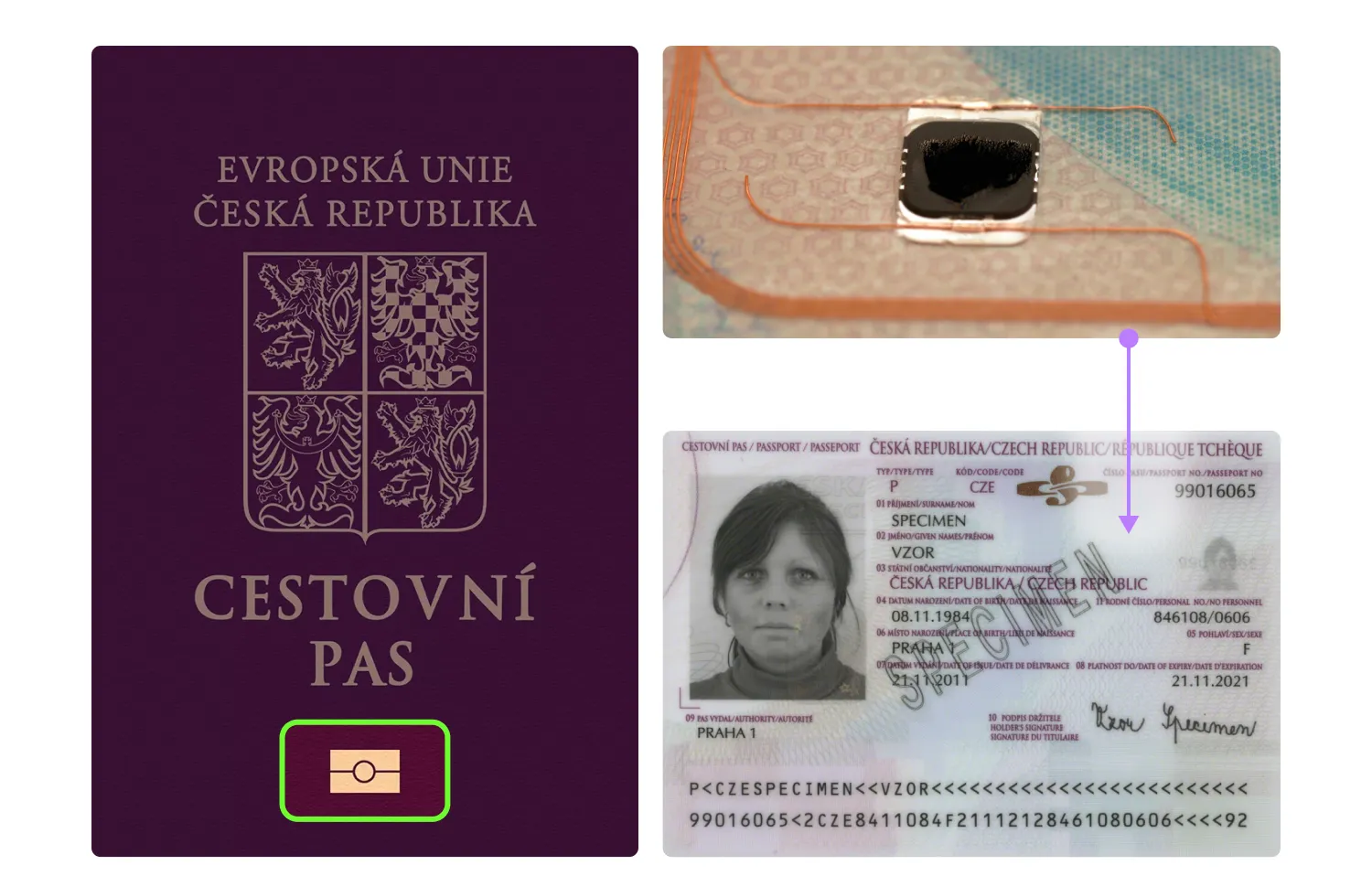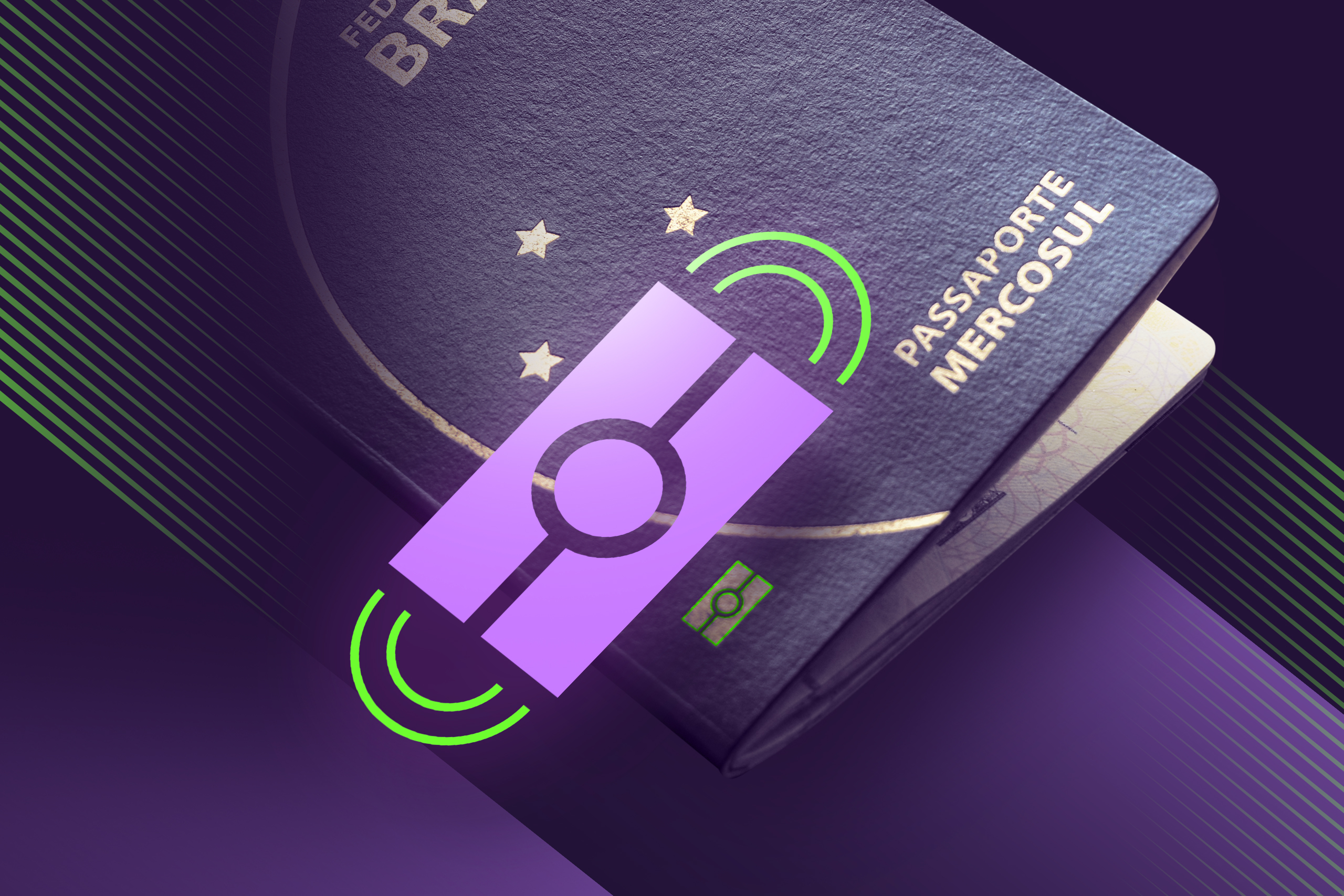Electronic passports, more commonly known as e-passports, have now become the standard in international travel. As of 2025, over 140 countries issue e-passports—and this list is ever expanding.
But why has this document virtually replaced traditional passports? Read further to find out.
What is an e-passport?
An e-passport (electronic passport) is a physical passport booklet that includes an embedded RFID microchip. The microchip typically contains the same information printed on the personal data page, along with the holder’s biometrics (e.g., digitized photograph, fingerprints, or iris scan). The latter is also the main reason why e-passports are often referred to as biometric passports.

Visually, e-passports can be recognized by the internationally accepted e-passport symbol (a small gold camera-shaped logo) on the cover.
What is the difference between an e-passport and a normal passport?
The traditional passport booklet does contain various anti-counterfeit features like holograms, watermarks, and optically variable ink (OVI), but it has no microprocessor or digital data. An e-passport, on the other hand, has all the security features of a regular passport plus an electronic chip that stores personal data and biometrics, as previously mentioned.
Practically speaking, an RFID chip is a significant security boost. With a regular passport, a forger might be able to physically alter the laminated photo page or other details well enough to pass a visual inspection. But with an e-passport check, even if the booklet is tampered with, the electronic record inside will expose the fraud as soon as it’s scanned. The holder’s identity information is protected by cryptography, and any attempt to manipulate this data (e.g., replacing the photo) will be detected.
How does an e-passport work?
At border control, the inspection system first scans the passport’s machine-readable zone (MRZ) to derive a key that unlocks the chip. (This is part of the Basic Access Control protocol.) Once unlocked, the chip’s contents are read via a short-range wireless connection.

The MRZ consists of one to three strings of characters (letters, digits, and separators) and may contain the document number, expiration date, holder name, gender, date of birth, and nationality.
The system then performs e-passport verification in two main steps.
First, it validates the authenticity of the data on the chip by checking the digital signature. The chip’s data file is digitally signed by the issuer with a CSCA certificate, and the system checks the certificate’s validity during Passive Authentication (PA). Additionally, the system performs Chip or Active Authentication to verify that the chip hasn’t been cloned, and that the data hasn’t been tampered with.
Second, the system verifies the traveler’s identity by comparing the biometric data on the chip to the person presenting the passport. For example, the chip’s stored photo is automatically compared to a live camera image of the traveler’s face. (If fingerprints are stored on the chip, a scanner can similarly match those.) This ensures the passport is being used by its rightful owner—even if someone has stolen an e-passport, they cannot clear this step unless their physical biometrics match the original holder’s.
What are the benefits of e-passports?
Keeping both holders and verifiers in mind, we can highlight four core benefits of e-passports (when compared to traditional passports):
Stronger anti-forgery mechanisms
The embedded RFID microchip makes e-passports incredibly forgery-resistant. The issuer’s digital signature contained in the chip is strongly encrypted: if any data is changed, the signature check will fail and the passport will be rejected. What’s more, this means that there’s little room for interpretation during verification: either the digital signature checks out, or it doesn’t—no guesswork or visual estimation required.
More protected against impersonations
Another key advantage of an e-passport is that it locks the document to its true owner. Since the chip includes a digital version of the holder’s biometrics, identity can be cross-checked against the actual person with high accuracy. This way, even if a criminal gets hold of the legitimate physical document, they won’t be able to match the biometrics.
Faster processing at borders
With the right infrastructure in place, e-passport verification at borders can be performed faster than manual checks. Automated checks read the chip, verify its integrity, and compare biometric data within seconds. For example, several countries have introduced e-gates that help reduce queues without lowering the quality of checks.
Allowing for global interoperability
E-passports follow international specifications laid out by the International Civil Aviation Organization (ICAO), which means they’re built to work universally across the globe. That makes verification consistent from one country to another, and allows immigration systems to quickly read and trust foreign documents. From the holder’s side, it also means that travelers are less likely to encounter delays or document confusion at unfamiliar checkpoints.
A final word on e-passports
E-passports offer clear security improvements over traditional passports, mainly thanks to the presence of an RFID chip. And the benefits don’t end there—e-passports are simply more convenient and future-proof, for both holders and verifiers.
This is why e-passports are seeing more and more adoption each year, and RFID/NFC technology is enabling more and more verifiers worldwide to consistently authenticate these documents—and prevent identity fraud.





